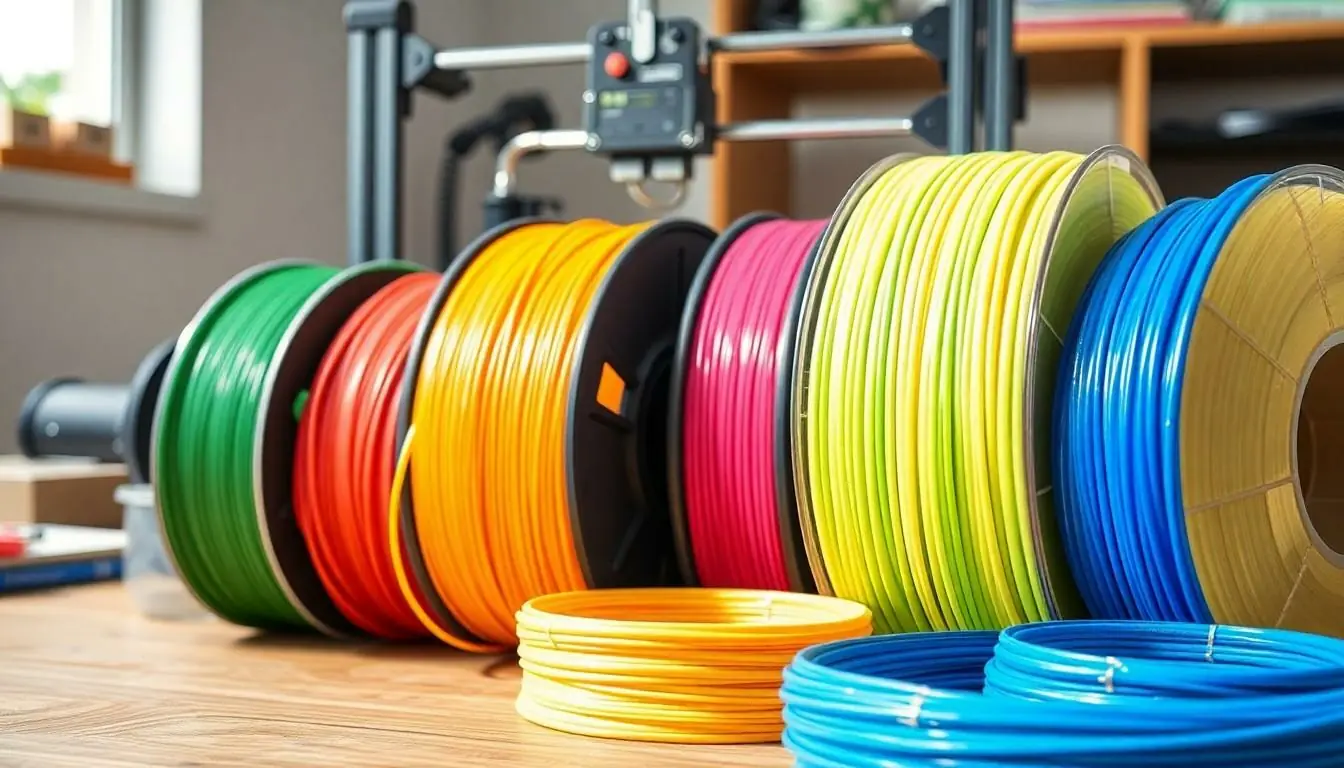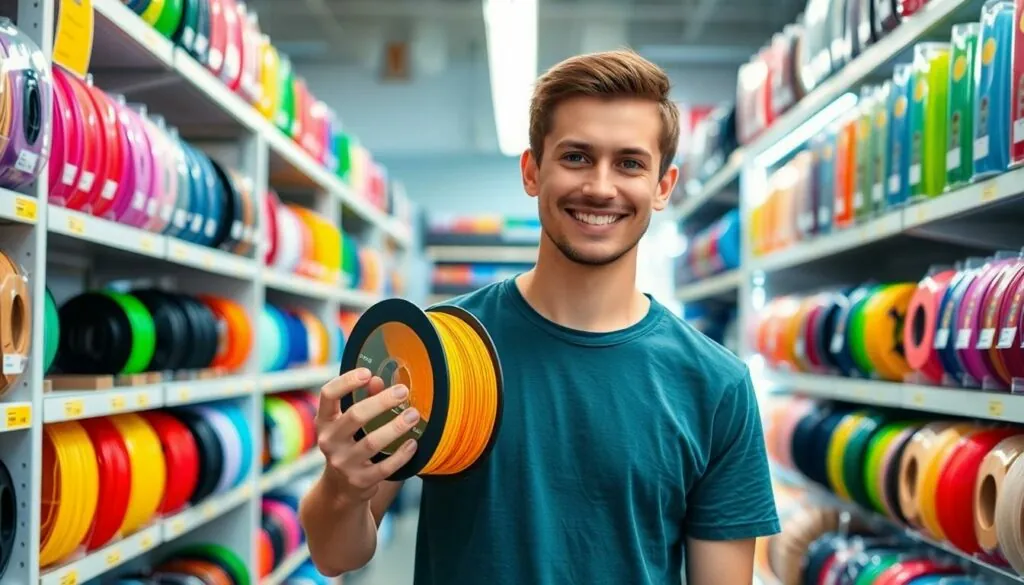Table of Contents
ToggleIn a world where creativity knows no bounds, 3D printing has become the ultimate playground for makers, inventors, and hobbyists alike. But what good is a 3D printer without the right filament? Imagine trying to bake a cake without flour—it just doesn’t work! Finding quality 3D printing filament nearby can be a game changer, turning your wildest designs into tangible masterpieces.
Understanding 3D Printing Filament
3D printing filament serves as the primary material used in additive manufacturing. Various types of filaments exist, each offering unique properties suitable for different applications. Common filament types include PLA, ABS, and PETG, with PLA being popular for its ease of use and biodegradable nature.
PLA stands for Polylactic Acid. It’s derived from renewable resources like cornstarch or sugarcane, making it an environmentally friendly option. Users often appreciate its low warping and ability to print detailed designs.
ABS, or Acrylonitrile Butadiene Styrene, provides greater durability and resistance to high temperatures. This makes ABS suitable for functional prototypes and more robust applications. It emits fumes while printing, so proper ventilation is vital during use.
PETG combines the best features of both PLA and ABS, yielding a filament that is both easy to print and exceptionally strong. Its resistance to impact and moisture makes it ideal for outdoor applications.
Understanding the differences between filament types enhances project outcomes. Quality filament impacts the overall print quality, affecting layer adhesion, strength, and appearance. Sourcing high-grade filaments increases the chances of achieving desired results.
Finding local suppliers ensures accessibility. Many online retailers stock a variety of filaments, but local shops often provide immediate solutions for urgent projects. Plus, engaging with local 3D printing communities offers insights into the best filaments based on personal experiences.
Choosing the right filament involves considering the specific project requirements. Each filament type brings unique characteristics that can significantly influence the final product. Prioritizing the right material leads to successful 3D printing endeavors.
Types of 3D Printing Filament

Understanding the various types of 3D printing filament is essential for optimizing project outcomes. Different materials offer unique properties that cater to specific applications.
PLA Filament
PLA filament stands out due to its ease of use and biodegradable nature. This filament works well for beginners and is compatible with most 3D printers. It prints at lower temperatures, reducing the risk of warping commonly seen in other materials. Bright colors are often available, enhancing the visual appeal of prints. Additionally, because it’s made from renewable resources, it’s a more sustainable choice for environmentally conscious users. However, it lacks the durability needed for functional parts, making it more suitable for prototypes and decorative items.
ABS Filament
ABS filament is known for its strength and durability, making it a preferred choice for functional parts. This material offers high-temperature resistance, which is essential in applications exposed to heat. To achieve optimal results while printing, proper ventilation is crucial due to the fumes it emits. While ABS prints require a heated bed to prevent warping, the finished products can withstand impacts and scratches. Many enthusiasts value its ability to be sanded and painted, allowing for refined finishes and modifications. Its versatility makes it suitable for a wide range of projects, from toys to automotive components.
PETG Filament
PETG filament provides a combination of strength and flexibility ideal for outdoor and functional prints. It’s known for its ease of printing, which reduces the likelihood of issues during the process. Excellent layer adhesion ensures strong prints, suited for applications requiring durability. Additionally, it displays resistance to impact and moisture, making it suitable for items exposed to various environments. Users appreciate its clarity, as many PETG filaments feature a transparent appearance. Lastly, unlike ABS, PETG does not emit strong fumes, which enhances the printing experience, especially in enclosed spaces.
Finding 3D Printing Filament Near Me
Locating 3D printing filament in your area involves exploring various resources. Local options often provide immediate access to materials.
Local Retail Stores
Retail stores that specialize in electronics or craft supplies typically stock 3D printing filaments. Major chains often carry commonly used types like PLA and ABS, while specialty stores may offer unique options. Checking inventories before visiting helps avoid wasted trips. Many stores provide expert advice on filament selection suited for specific projects. Engaging with staff can clarify filament properties and recommended uses. Local makerspaces sometimes have filament available for purchase, along with additional resources for 3D printing enthusiasts.
Online Options
E-commerce platforms host a variety of 3D printing filaments, enabling easy comparison of prices and types. Websites like Amazon and specialty retailers often feature extensive selections, including rare filaments. Reading user reviews can assist in assessing quality and compatibility with different printers. Many online suppliers offer fast shipping, making it convenient to order materials directly to your doorstep. Searching for local sellers on these platforms might reveal pickup options, enhancing the shopping experience. Regular discounts and promotions can provide significant savings while stocking up on essential materials.
Factors to Consider When Choosing Filament
Selecting the right filament for 3D printing involves several essential factors that impact outcomes. These include quality, durability, cost, and availability.
Quality and Durability
Filament quality directly influences print performance. High-quality filament ensures consistent extrusion, leading to superior layer adhesion and a smoother finish. Durability matters for functional prints. Strong filaments, like ABS and PETG, resist impact and heat, making them suitable for mechanical parts. In contrast, PLA is more brittle, limiting its use in stress-prone applications. Evaluating specifications from manufacturers helps determine suitable options for specific projects. Look for filaments tested for consistency to avoid unexpected failures during printing.
Cost and Availability
Cost often drives filament selection, impacting both budget and material choices. Local suppliers offer competitive pricing and immediate access, saving on shipping costs. Brands and types vary significantly in price, so comparing options aids in finding a reliable balance between cost and quality. Availability also plays a crucial role. Popular filaments like PLA and ABS typically stock local electronics or craft stores. For unique materials or colors, online platforms provide broader selections. Checking local inventories and user reviews can greatly guide purchasing decisions, ensuring continued project success.
Finding the right 3D printing filament nearby can significantly enhance any project. By exploring local suppliers and engaging with the community, makers can access quality materials that suit their specific needs. Whether it’s PLA for quick prototypes or ABS for durable parts, knowing where to source these filaments ensures a smoother printing experience.
Quality filament not only impacts the final product but also boosts creativity and innovation. With the right resources at hand, anyone can turn their imaginative designs into reality. So take the time to discover local options and elevate your 3D printing journey.

